This post may contain affiliate links. Please see our disclosure policy.
Canning sausage potato and kale soup means you have a delicious comfort food meal in a jar ready to go at a moment’s notice. This particular recipe is similar to Olive Garden’s “Zuppa Toscana” and even better when served with a splash of cream.
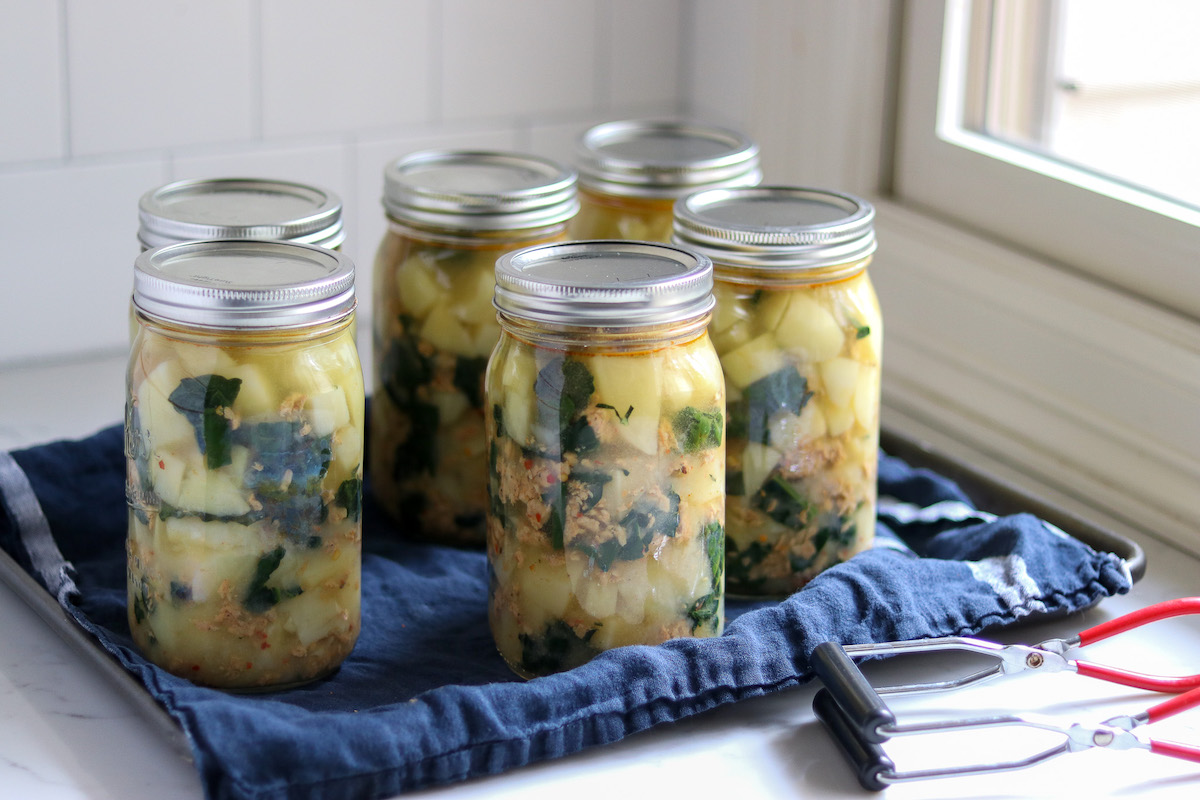
Table of Contents
Home canned soups are an easy way to store ready-to-heat and eat meals right on your pantry shelf. This particular recipe is exceptionally comforting, especially when served with a splash of cream for extra richness.
This simple recipe for sausage, potato and kale soup is a copycat recipe that’s very similar to Olive Garden’s “Zuppa Toscana,” especially when served with cream and breadsticks.
It can’t be thickened before canning, but you can thicken it to serve if you choose.
It’s also absolutely delicious as is; just heat and eat right out of the jar.
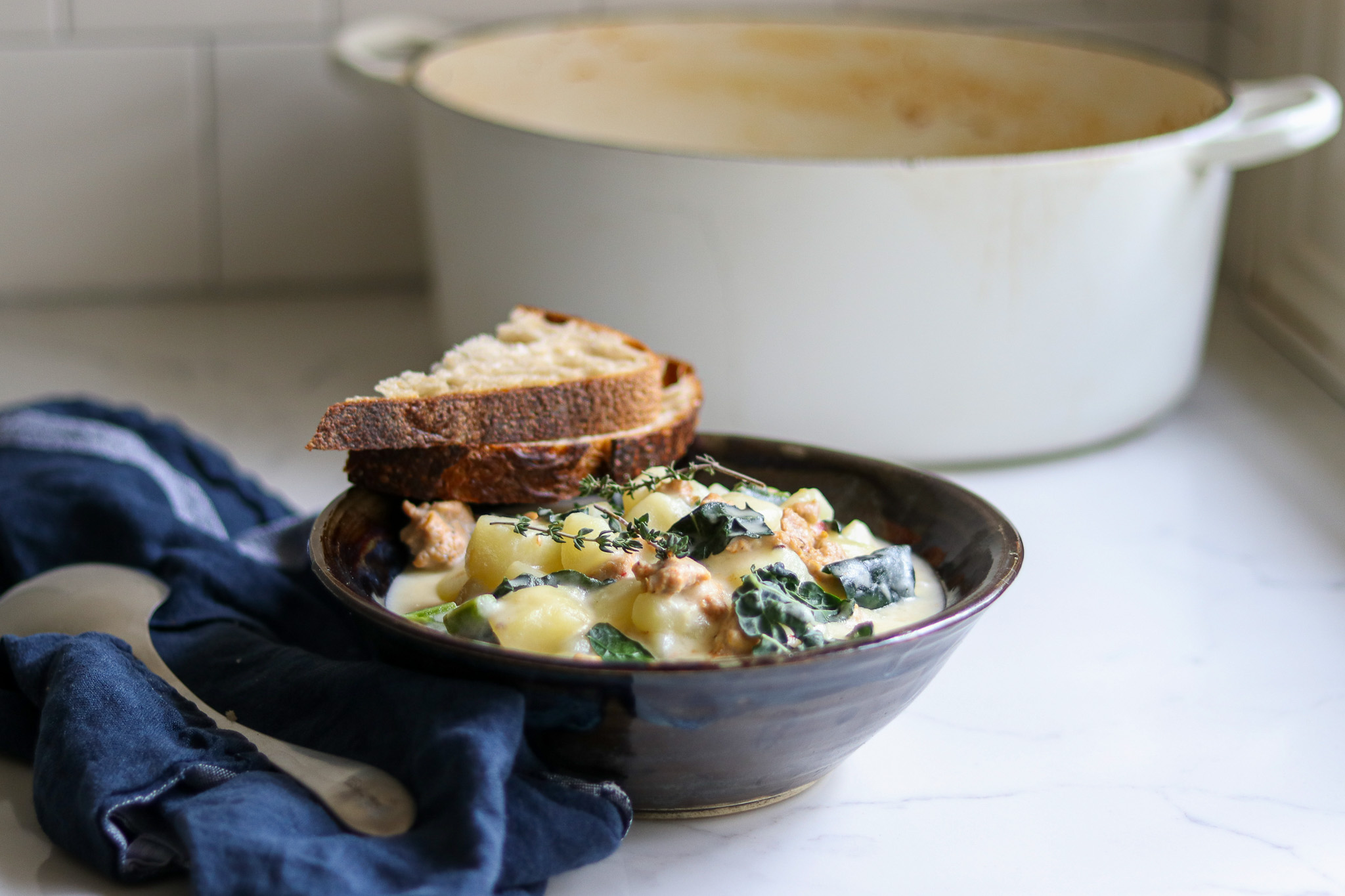
Ingredients for Zuppa Toscana
The ingredients for canning sausage potato and kale soup are quite simple, and the recipe’s name pretty much sums up the ingredient list.
To make a canner batch of 7 quarts (or 14 pints), you’ll need the following:
- 3 lbs (1.4 kg) ground sausage (seasoned or plain)
- 4 1/2 lbs (2 kg) peeled and cubed potatoes (1/2 inch cubes)*
- 1 lbs (450 g) de-stemmed and chopped kale*
- 10 cups chicken broth, vegetable broth, or water
- 1 to 2 tbsp canning salt
- 1 Tbsp ground black pepper
You can use seasoned sausage (like Italian sausage or chorizo) for this recipe, or unseasoned ground pork. The salt in this recipe is designed to account for seasoned prepared sausage with salt added. If using unseasoned sausage, you’ll likely need a bit more salt for flavor, and you might also want to add some dry spices like garlic and paprika.
(Adjust to your tastes. You’re always allowed to add more or less salt to pressure caning recipes, and you’re able to use a reasonable amount of any dry seasoning as well.)
The quantity of potato and kale in this recipe is weighed once prepared. To make about 4 1/2 lbs of peeled potatoes, you’ll need about 5 pounds as purchased. Likewise, for 1 lbs of stemmed kale, you’ll need about 1 1/4 to 1 1/2 lbs with stems.
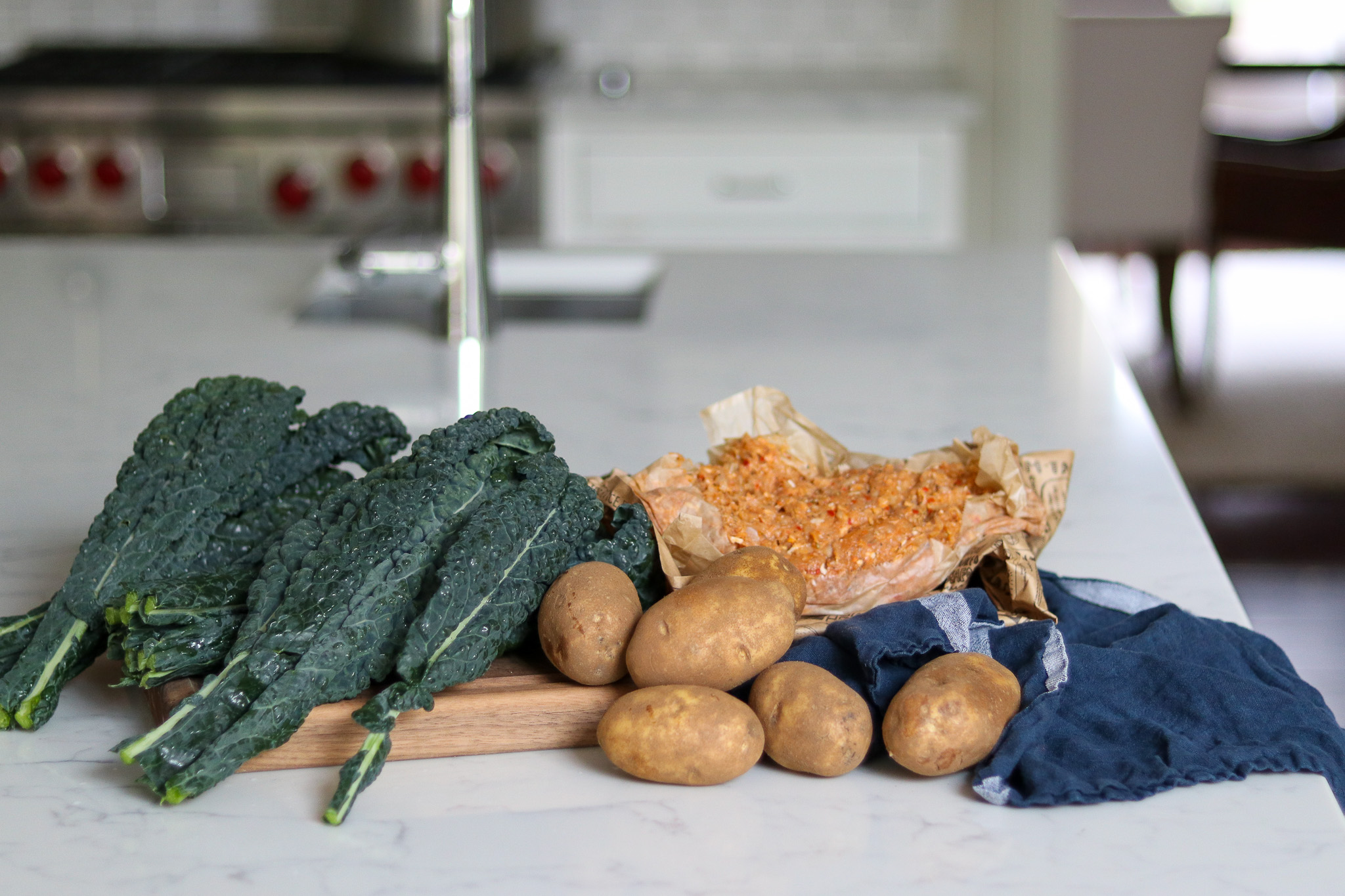
Once canned, this soup can be served as is, or you can add 1/2 cup heavy cream or half and half per quart. For a thickened soup, you can also add a cornstarch slurry made with 1 tbsp of cornstarch per quart.
Keep in mind that cream and cornstarch cannot be added before canning. They’re optional, and if you choose to use them, they can only be added at serving.
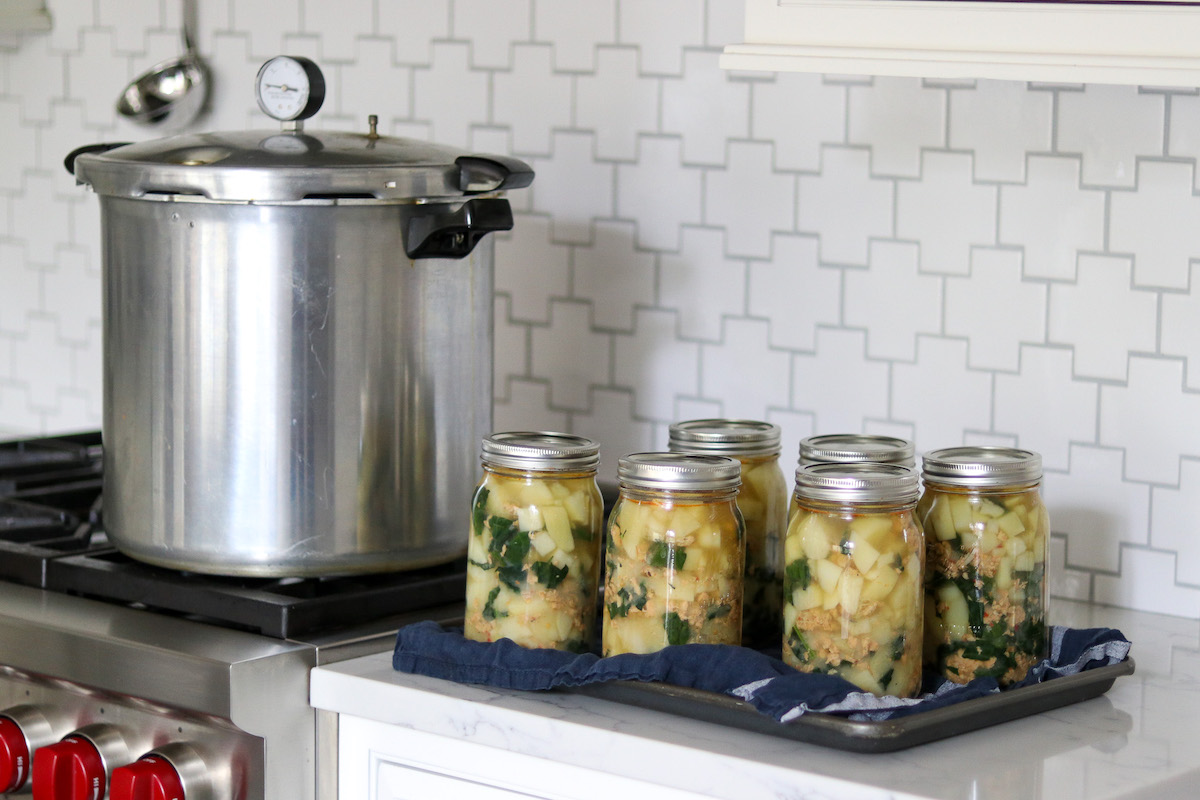
Canning Sausage, Potato & Kale Soup
This is a hot pack canning recipe, and all the ingredients will need to be simmered together before adding to canning jars.
Prepare a pressure canner, along with jars, lids, and rings. For most canners, this means adding 2 to 3 inches of water and bringing it up to around just simmering (around 180 degrees F). Follow the instructions on your particular brand of pressure canner.
Once the canner is prepared, you can start making the soup.
Start by preparing your potatoes. You’ll need about 5 lbs of potatoes as purchased to make 4 1/2 lbs of peeled and diced potatoes (1/2 inch dice).
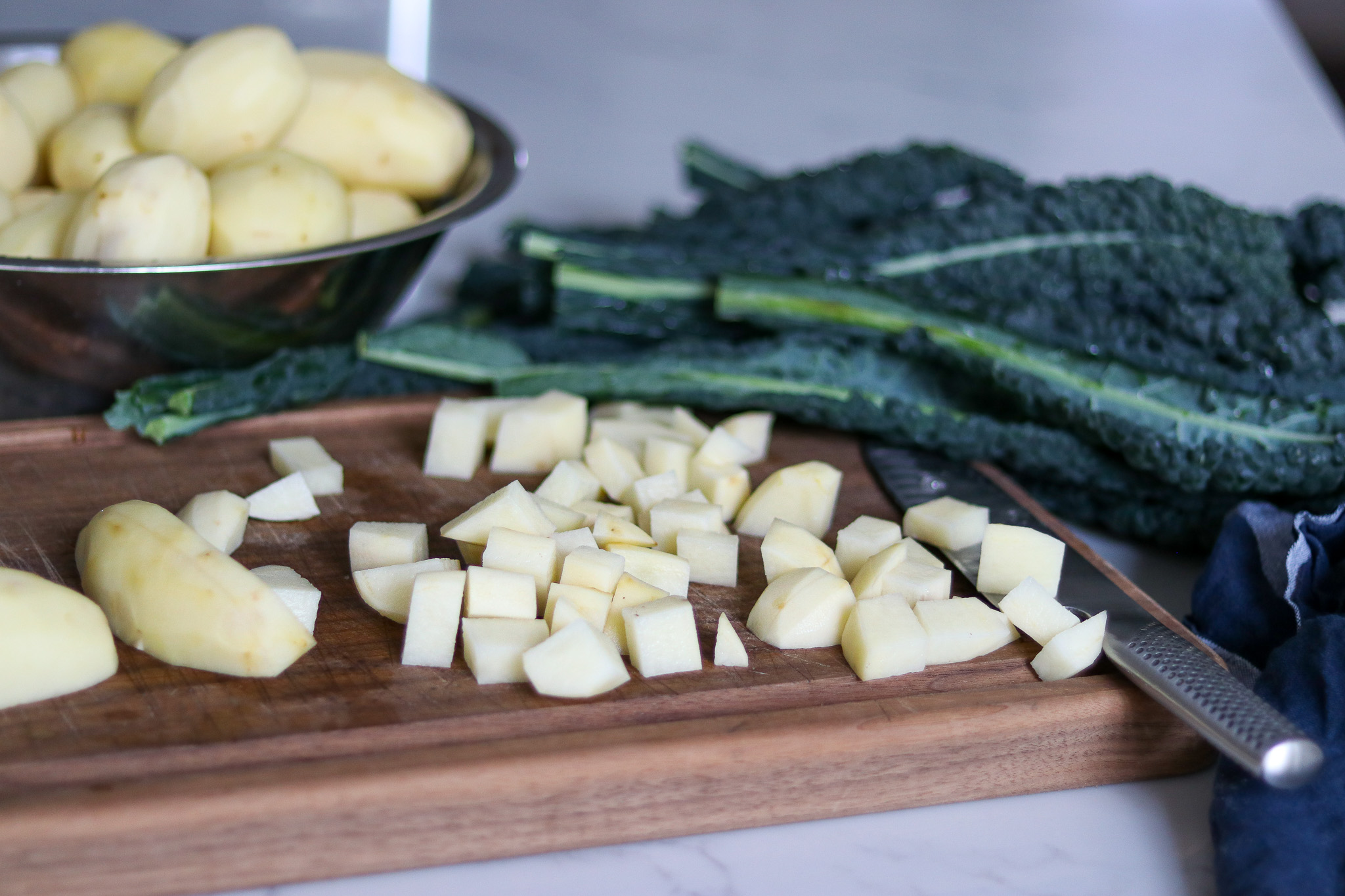
Next, prepare the kale.
Kale stems can be added, but they tend to get tough during canning. I’d recommend just using the leaves and removing the potentially tough and stringy stems. (You can also make this recipe using chard, and in that case, go ahead and leave in the stems.)
It takes about 1 1/4 to 1 1/2 lbs of kale as purchased to make 1 lbs of kale leaves (trimmed).
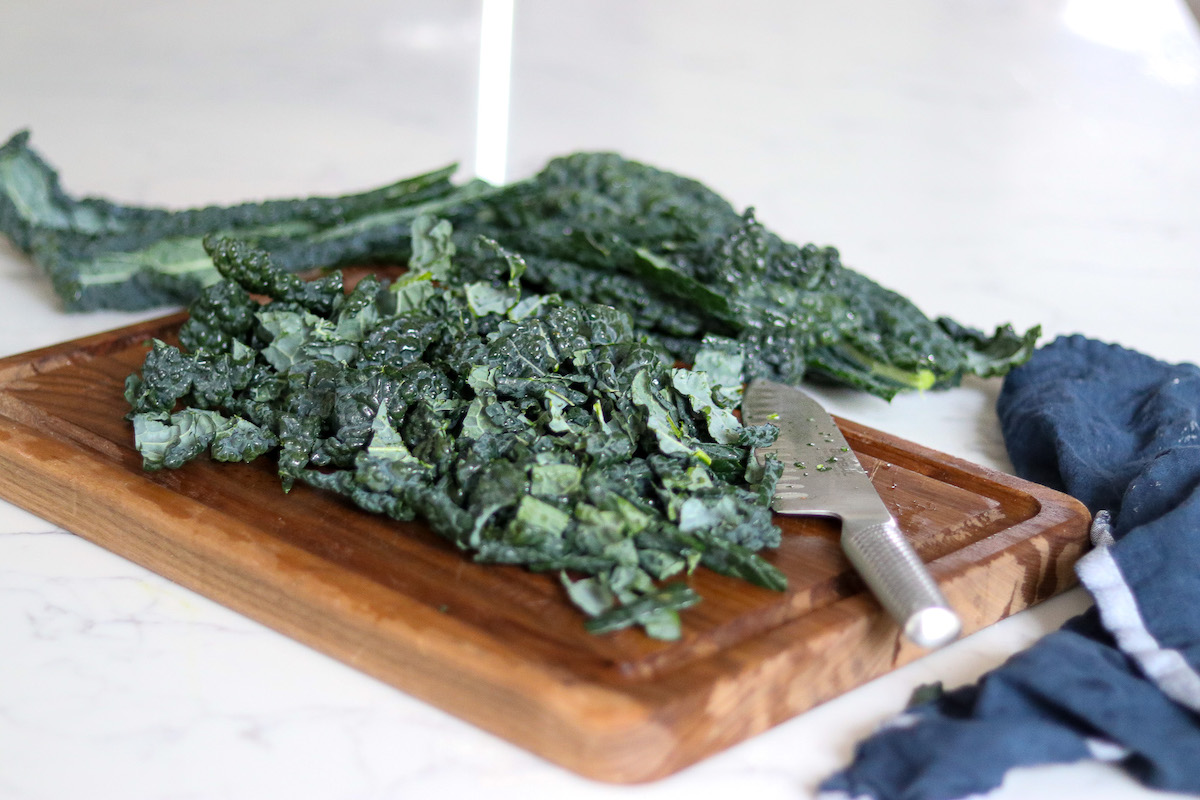
Once your vegetables are prepared, it’s time to brown the sausage. Raw meat tends to lead to poor-quality home-canned soups, and it’s always recommended that you pre-brown the meat.
Brown the sausage over medium heat. This should take about 10 minutes.
Stir occasionally to encourage even browning, but try to leave some small chunks, and don’t break it up too much.
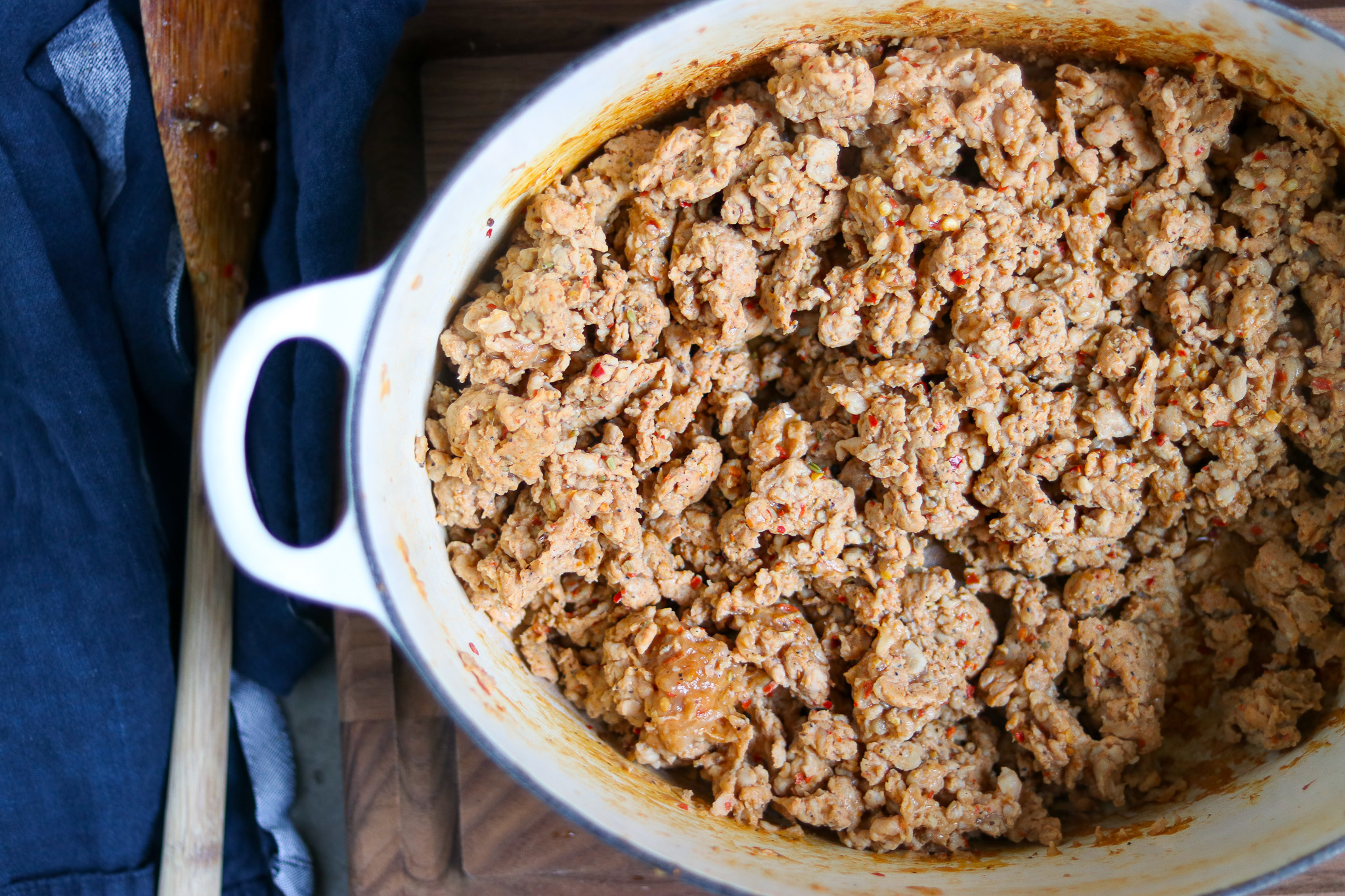
Once the sausage is browned, add in the vegetables, seasonings, salt, and the broth or water. Personally, I like to use homemade chicken broth, but vegetable broth or pork stock also work well.
Some people use half stock and half water, or all water. Using broth will result in a richer stock. If using broth with added salt, be sure to reduce the salt in the recipe accordingly.
Bring the mixture to a simmer on the stove and cook for about 5 minutes until all the ingredients are heated through.
Remove the pot from the heat and ladle into prepared jars (pints or quarts), leaving 1” headspace.

Once filled, de-bubble jars, adjust headspace, and then cap the jars with 2-part canning lids and seal with rings to finger tight.
Load the jars into the canner on your canning trivet and add the lid. Turn the heat up to high.
Allow the canner to vent steam for 10 minutes, then seal the canner and bring it up to pressure.
This soup is canned at 10 pounds of pressure at sea level, but you’ll need to adjust for altitude if you’re about 1,000 feet in elevation.
Process times are 75 minutes for pints and 90 minutes for quarts.
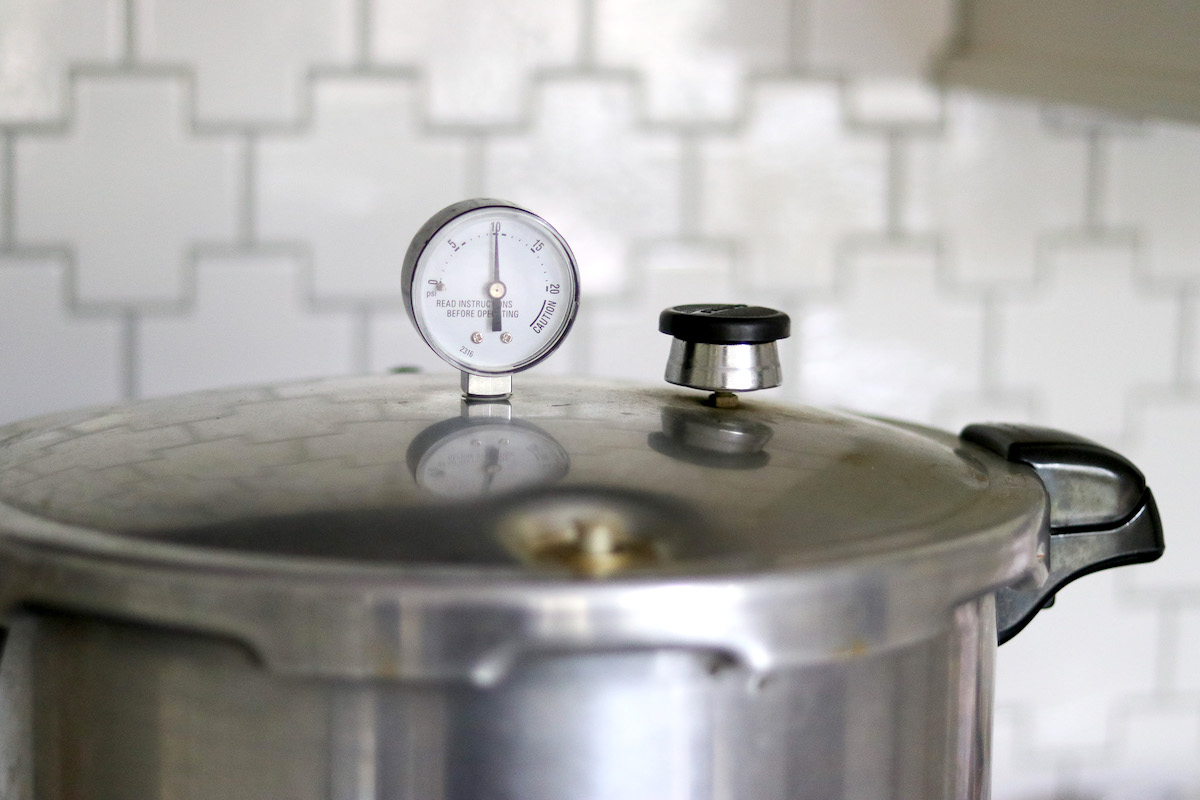
Altitude Adjustments
The canning time for this soup remains the same regardless of altitude. Pint jars are processed for 75 minutes, and quart jars are processed for 90 minutes.
Pressure, however, changes based on elevation and the type of canner you’re using.
Altitude adjustments for canning sausage potato and kale soup are as follows:
For dial gauge pressure canners:
- 0 to 2,000 feet in elevation – 11 lbs pressure
- 2,001 to 4,000 feet in elevation – 12 lbs pressure
- 4,001 to 6,000 feet in elevation – 13 lbs pressure
- 6,001 to 8,000 feet in elevation – 14 lbs pressure
For weighted gauge pressure canners:
- 0 to 1,000 feet in elevation – 10 lbs pressure
- Above 1,000 feet – 15 lbs pressure
Note that in general, the USDA suggests canning times of 60 minutes for soup pints, and 75 minutes for quarts, but those recipes have much more liquid in the jars. Their chicken soup recipe, for example, has the jars only half filled with solids.
This recipe uses the times for meat and other dense, full jar recipes developed by the USDA. Be sure to use the full 75 minutes for pints and 90 minutes for quarts for this recipe, rather than the generic soup processing instructions.
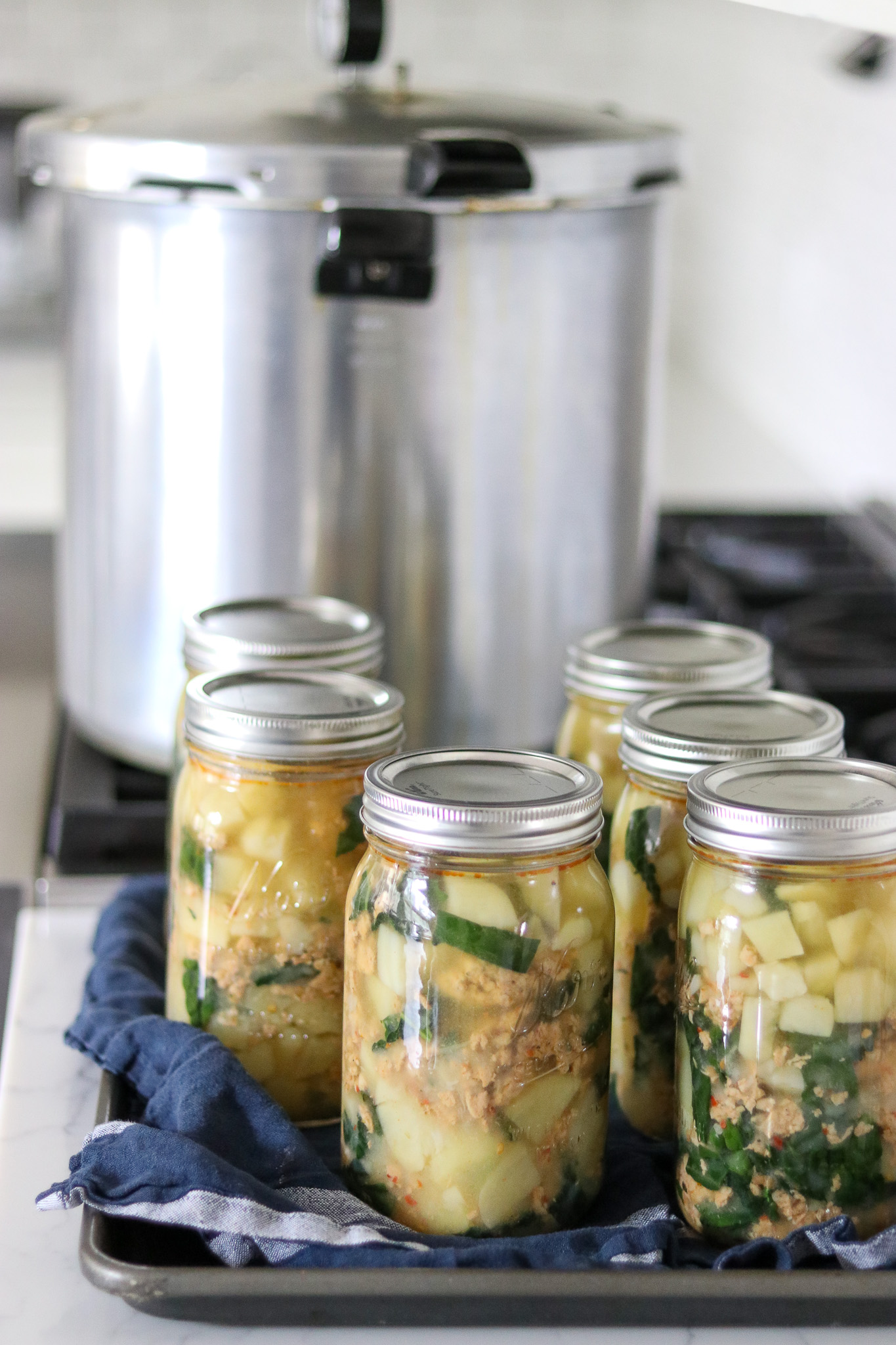
Once the canning time is complete, turn off the heat and allow the canner to cool to room temperature naturally.
Once completely cool, remove the jars and place them on a towel on the counter.
Even when the canner is cool, the jars may still be a bit hot, so make sure you let them finish cooling completely on the counter.
Once all the way cool, check seals and store any unsealed jars in the refrigerator for immediate use.
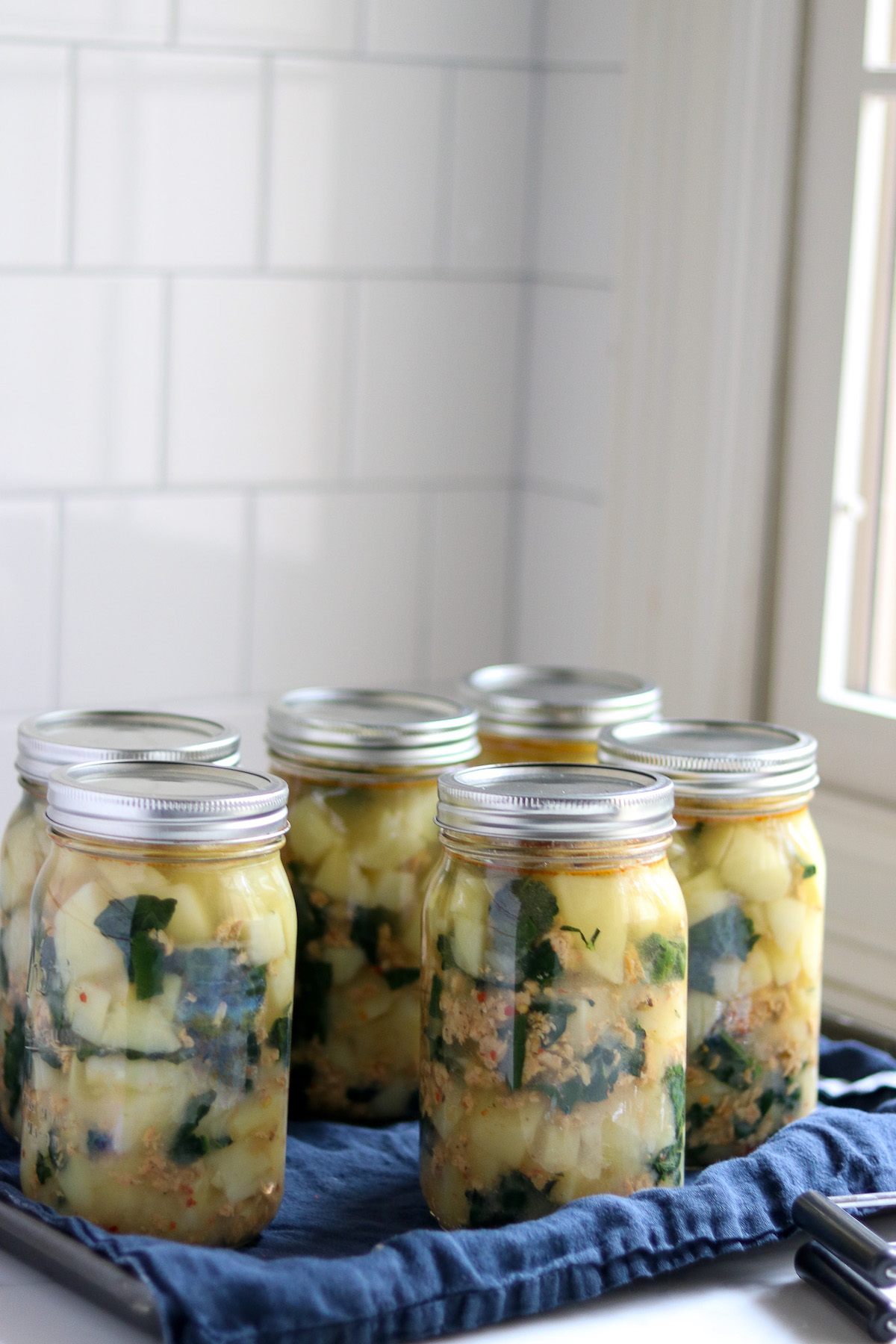
Properly pressure-canned and sealed jars of sausage, potato, and kale soup will maintain peak quality on the pantry shelf for 12 to 18 months.
After that point, the jars are still fine to eat provided they’re still sealed…but the quality will start to degrade.
Refrigerate after opening.
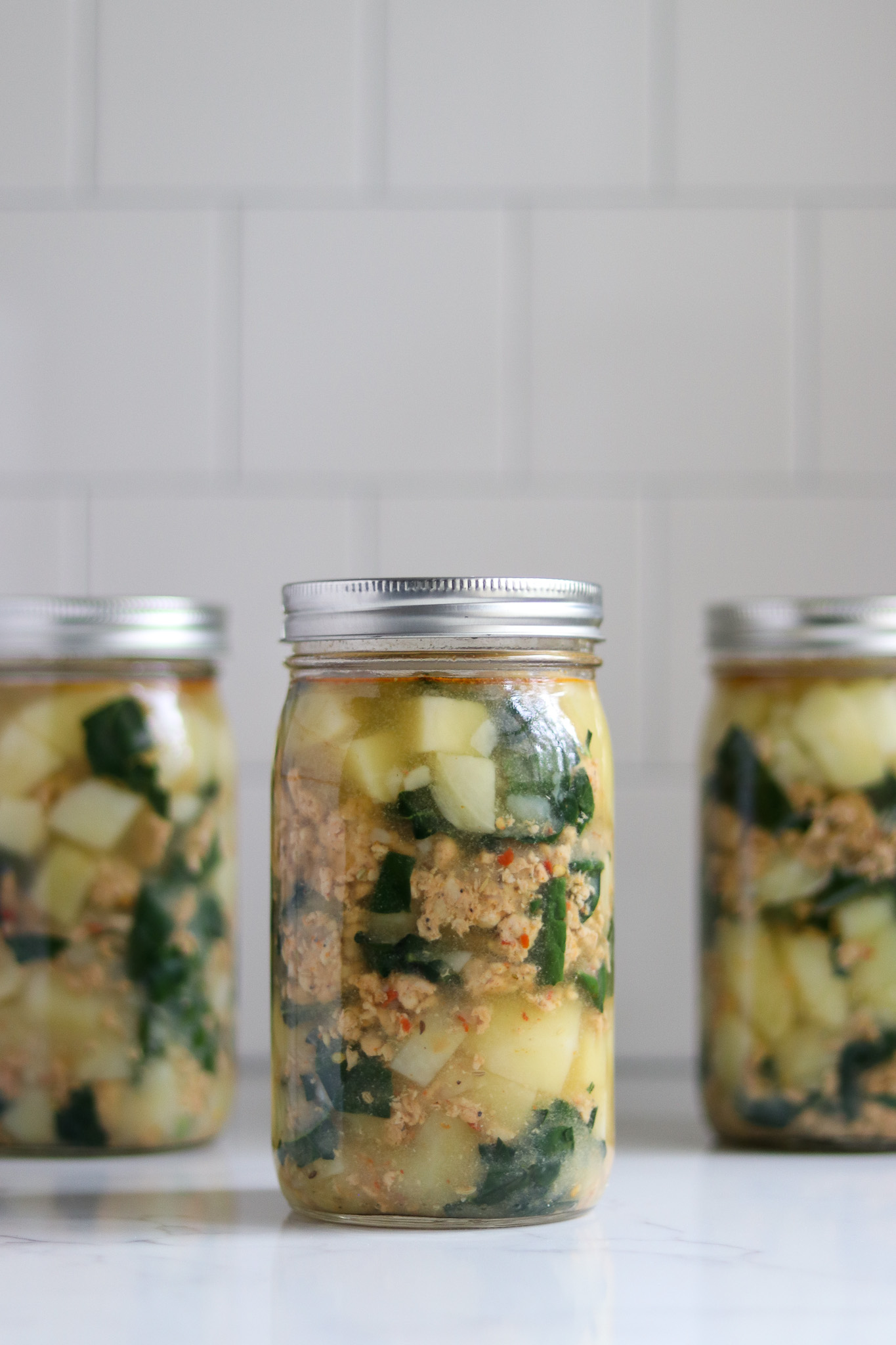
Serving Sausage, Potato & Kale Soup
To serve, empty the contents of a quart jar into a saucepan and gently heat over medium-low heat. This should take about 10 minutes for everything to fully heat through.
If you’d like, you can thicken the soup with a cornstarch slurry made with 1 tbsp of cornstarch per quart. You can also add about 1/2 cup of heavy cream or half and half per quart.
A sprinkling of fresh herbs is really amazing too, and it’s best served with toast or breadsticks.
All of these things are optional, and it’s also perfectly fine as a simple heat-and-eat meal in a jar.
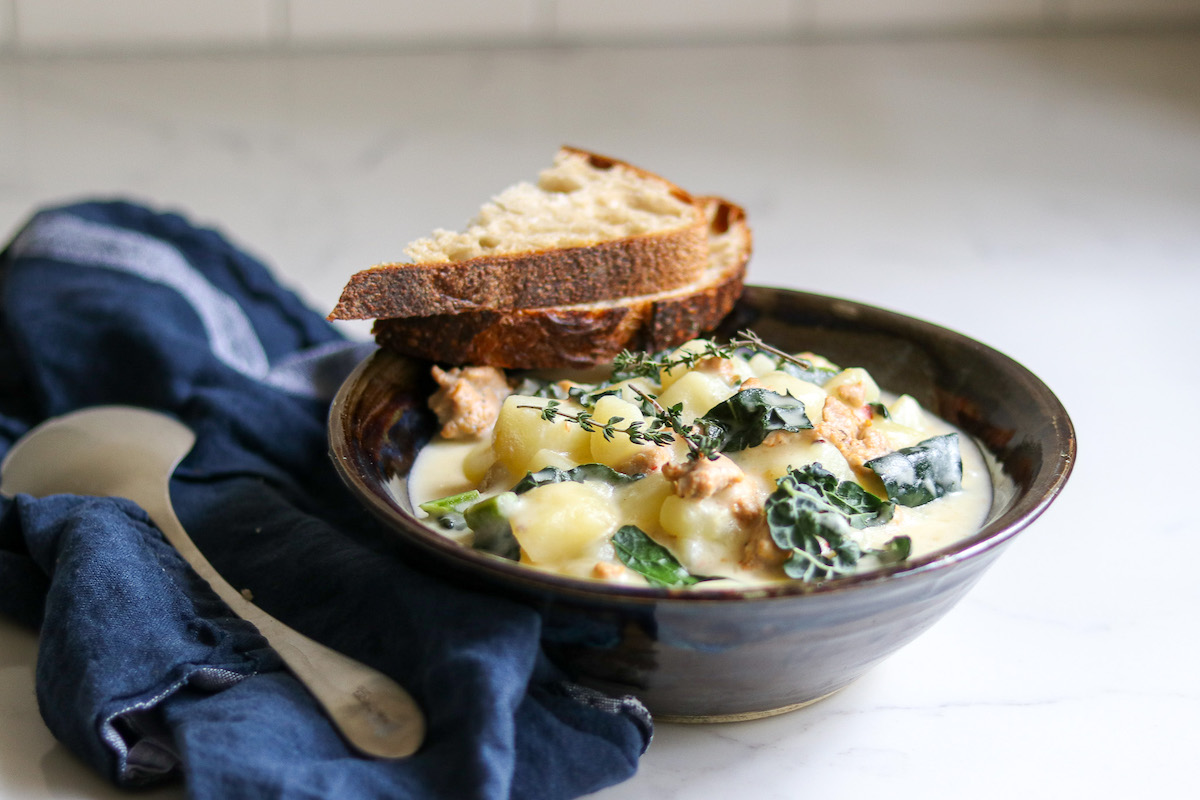
Soup Canning Recipes
Looking for more soup canning recipes?
This canning recipe for Sausage, Potato, and Kale soup is adapted from Angi Schneider’s cookbook, Pressure Canning for Beginners and Beyond. Lovely pictures in this post by Chez LaRae.
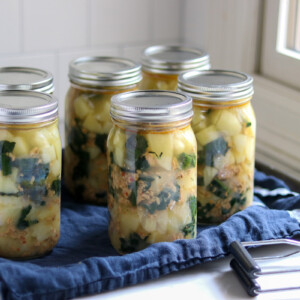
Canning Sausage Potato and Kale Soup (Copycat Zuppa Toscana)
Equipment
Ingredients
- 3 lbs ground sausage, seasoned or plain
- 4 1/2 lbs potatoes, peeled and cut into 1/2 inch cubes
- 1 lb kale, destemmed and chopped
- 10 cups chicken broth, vegetable broth, or water
- 1 to 2 tbsp canning salt, less if using salted broth
- 1 Tbsp ground black pepper
Instructions
- Prepare a pressure canner, along with jars, lids, and rings. For most canners, this means adding 2 to 3 inches of water and bringing it up to around just simmering (around 180 degrees F). Follow the instructions on your particular brand of pressure canner.
- Chop the potatoes into 1/2 inch dice and weigh out 4 1/2 lbs. Remove the kale ribs and weigh out 1 lbs.
- Brown the sausage over medium heat, stirring occasionally. This should take about 8 to 10 minutes.
- Add the prepared vegetables, seasoning, salt and broth or water.
- Bring to a simmer and cook for 5 minutes until everything is heated through.
- Remove from heat and ladle the soup into prepared jars, leaving 1'' headspace.
- Once filled, de-bubble jars, adjust headspace, and then cap the jars with 2-part canning lids and seal with rings to finger tight.
- Load the jars into the canner on your canning trivet and add the lid. Turn the heat up to high.
- Allow the canner to vent steam for 10 minutes, then seal the canner and bring it up to pressure. (Follow the instructions on your canner.)
- This soup is canned at 10 pounds of pressure at sea level, but you'll need to adjust for altitude if you're about 1,000 feet in elevation. *see notes
- Process jars for 75 minutes for pints and 90 minutes for quarts.
Notes
Ingredient Notes
You can use seasoned sausage (like Italian sausage or chorizo) for this recipe, or unseasoned ground pork. The salt in this recipe is designed to account for seasoned prepared sausage with salt added. If using unseasoned sausage, you'll likely need a bit more salt for flavor, and you might also want to add some dry spices like garlic and paprika. (Adjust to your tastes. You're always allowed to add more or less salt to pressure caning recipes, and you're able to use a reasonable amount of any dry seasoning as well.) The quantity of potato and kale in this recipe is weighed once prepared. To make about 4 1/2 lbs of peeled potatoes from 5 pounds whole as purchased. Likewise, for 1 lb of stemmed kale, you'll need about 1 1/4 to 1 1/2 lbs with stems.Altitude Adjustments
The canning time for this soup remains the same regardless of altitude. Pint jars are processed for 75 minutes, and quart jars are processed for 90 minutes. Pressure, however, changes based on elevation and the type of canner you're using. Altitude adjustments for canning sausage potato and kale soup are as follows:For dial gauge pressure canners:
- 0 to 2,000 feet in elevation – 11 lbs pressure
- 2,001 to 4,000 feet in elevation – 12 lbs pressure
- 4,001 to 6,000 feet in elevation – 13 lbs pressure
- 6,001 to 8,000 feet in elevation – 14 lbs pressure
For weighted gauge pressure canners:
- 0 to 1,000 feet in elevation – 10 lbs pressure
- Above 1,000 feet – 15 lbs pressure
Serving Notes
To serve, empty the contents of a quart jar into a saucepan and gently heat over medium-low heat. This should take about 10 minutes for everything to fully heat through. If you'd like, you can thicken the soup with a cornstarch slurry made with 1 tbsp of cornstarch per quart. You can also add about 1/2 cup of heavy cream or half and half per quart. A sprinkling of fresh herbs is really amazing too, and it's best served with toast or breadsticks. All of these things are optional, and it's also perfectly fine as a simple heat-and-eat meal in a jar.Variations and Changes
The most common question I get asked on this recipe is about adding onions or garlic, and those can be added safely provided you don't overpack the jars. Remove a cup or two from the total amount of potoes and you can substitute an equal amount of diced onion (or add an extra jar to the batch).Nutrition
Nutrition information is automatically calculated, so should only be used as an approximation.
Pressure Canning Recipes
Keep that pressure canner running with these pressure-canning recipes:

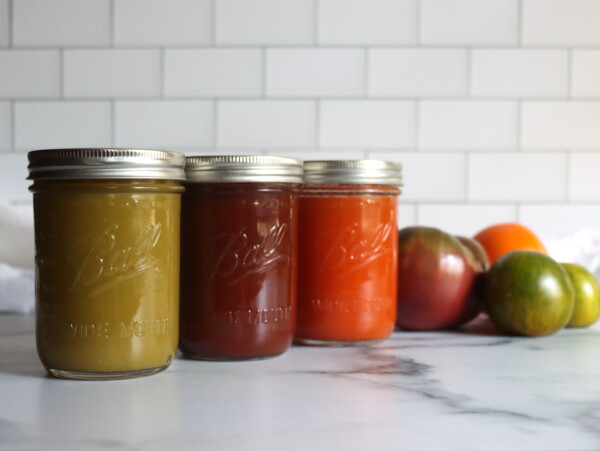
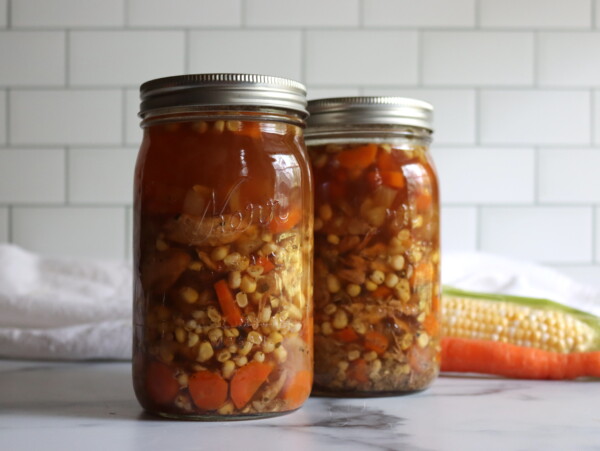
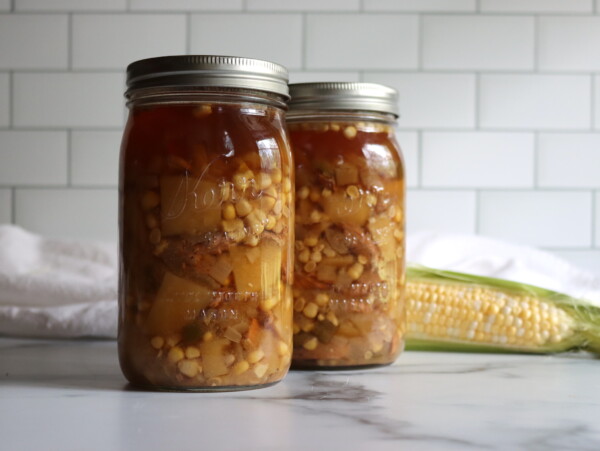
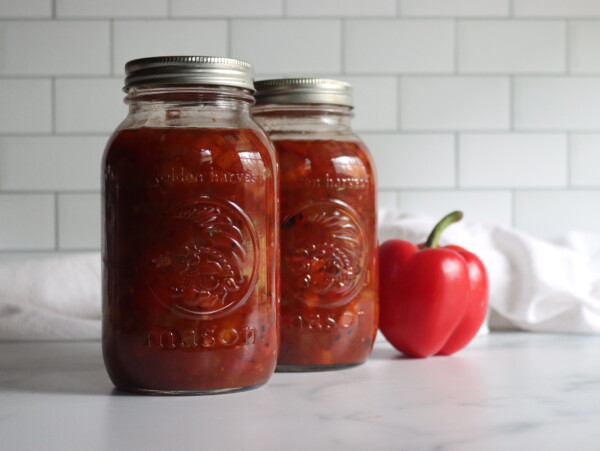
I can’tmake enough of this for my friends and my nieces
I’m so glad everyone’s loving it!
5 stars for the recipe because it’s one of my family’s favorites things that I can. My only critique is I’ve made this recipe, as written, several times and I never have enough for 7 jars. I consistently get 6 jars and I have to add more broth to fill them.
This is not a critique of this particular recipe, just an observation… I canned Zuppa Toscana soup last summer and found that I prefer it freshly made. When canned, the vegetables become soggy, the meat overcooked, definitely not the gourmet treat I get at Olive Garden!
I just canned this soup, and two of the jars have spinach up by the lid that won’t shake down, almost like they are partly under lid. The lids feel and look sealed. Do you think they are safe to put on shelves? Or should I refrigerate them?
That’s a tricky call. If they’re properly sealed, the contents don’t have to be under the water line and it’s fine if they’re up stuck to the lid. Anything above the waterline will degrade faster, and you should use those jars first. However, if they’re not actually sealed…then the can’t be stored on the pantry shelf and should go immediately into the refrigerator. I can’t make this call for you, so you’ll have to use your best judgement.
Just made this today. I used mild Italian sausage and spicey. Very tasty. 😋 I canned four quarts in my Nesco pressure canner – three of the four leaked broth during the process. Why? I used the same Ball lids for each.
Jars leaking in the canner is usually related to temperature swings inside the canner, like the element bringing the temperature up too fast. That’s one of the downsides of the nesco, it has less thermal mass than a normal canner, so it heats faster with a powerful electric element…but that can have drawbacks too. One way to help prevent that is to make sure the soup is piping hot when it goes into the canner, and that the water in the canner is really hot when you add the jars. Then everything starts close to boiling, and there’s not much of a swing when the heating element kicks on. There is a learning curve with those electic ones, and that’s one of the tricks.
Hope this helps!
I just tried canning this today and there is a very dark liquid floating at the top of most of the jars (like the fat mixed with the kale coloring, I assume). it looks ominous. Have you encountered this?
Side note, we tried this out before canning and it is delicious! Hoping the batch isn’t ruined somehow.
If the jars are sealed and were processed the correct amount of time, they’re fine. Often depending on your particular ingredients you can get discoloration, and that’s normal. Some potatoes, for example, will turn brown in the pressure canner because they’re a bit sweeter and the sugars caramelize. If I made this and ended up having a kale colored oil at the top of the jars, I’d call that normal (and likely related to your particular sausage or kale that you used, since there’s so much variation in ingredients). But I wouldn’t see it as a safety thing. Enjoy!
Hi! This is just what I’ve been looking for, thank you. Is there any way I could add white beans? I see for adding onions you say to remove some of the potatoes or just add another jar. Could the same thing be done with presoaked, precooked white beans?
Beans are tricky when it comes to adding them to canning recipes because they absorb a lot of water and can lead to dry jars or overly thick soups. One thing you could do is make this recipe as a “brothy soup” which has you fill the jars halfway with solids and then the rest of the way with liquid to 1 inch headspace. In brothy soup recipes, you are allowed to add beans because there’s plenty of liquid in there. I have more information on this in my guide to making your own soup canning recipe here: https://creativecanning.com/choice-soup-canning-recipe/
Any reason the potatoes need to be peeled if the potatoes used have thin skins like Yukon gold or red potatoes?
The skins will fall off in canning and float around the jar, making for a weird texture when you serve the soup. That’s the quality reason.
The safety reason is that according to the NCHFP, canning times for potatoes and other root vegetables were developed assuming peeling. Soil is where botulism spores are found, so anything grown underground in dirt has more of a chance of carrying that sort of thing. They have you peel it to remove the soil contact layer.
Hi. Is this recipe ok with turkey sausage and/or unseasoned ground turkey? Or, do any processing times or headspace need to be changed/adjusted with turkey?
You can use ground turkey or turkey sausage in this recipe with no adjustments. That’s a fine substitution. Enjoy!
Do the potatoes need to be tender before canning or should they still be undercooked as they’ll cook in the pressure canning process? I am hoping to make a large batch, part for canning, part for lunch for the week so I wasn’t sure if I needed to start the canning process before the potatoes were ready.
The potatoes are still quite firm when it goes into the canner. They’re heated through, but not tender. I’d say that you’ll need to get the first half canning and then keep cooking the rest for another 15 to 20 ish minutes for it to be fully done.
Can you safely add cooked bacon and sauted onion to this canning recipe?
Sauteed onion is fine for canning, but bacon is not an “approved” canning ingredient because it hasn’t been specifically tested. You can, however, use salt pork in this recipe since that’s not cured, just salted. It’s the curing that is the not tested part. Best of luck!
Can I use frozen kale for this recipe? I have lots saved from last years garden.
Yes, you can use frozen, that’s fine. Enjoy!
Can you substitute cauliflower for the potatoes for a low carb option?
Califlower isn’t tested for canning (other than as pickles). It may well be fine, but it’s not specifically tested. The reason is cruciferous veggies (broccoli, cauliflower, cabbage, etc) tend to get a sulphur taste when pressure canned, so given that, they didn’t bother testing any of them for anything in a pressure canner.
Can I use pancetta instead of sausage?
According to the NCHFP in the US, salt cured meats aren’t tested for canning and they’re not quite sure how they’ll do in the canner. Pancetta in particular is a lot more dense than sausage, so it’s hard to say if it’d heat all the way through in canning. Since it’s not tested, I don’t have any recommendations for you one way or the other.
Hi Ms Ashley,
!.) I am in Canada and we’re metric. So I hauled out the old slide rule and tried to make the recipe for 14 pints give me the 18 500ml jars that my canner will hold. Didn’t quite get it right, had to add more broth, and some of the jars only had veggie broth, but all got done. I am setting up a spreadsheet to convert this-to-that so I can get full canner loads despite the differences in recipes and measuring systems; if I get it working I’ll send it to you (I owe you Sooo Much!)
2.) So here’s the report: Finally got it all together — you must be a ball of lightening, I can’t get it all ready to can in 20 min. more like 2 days. However, I did finally get it all together and pressure canned. But one jar did not seal (alors!), what a problem! Clearly the DH and I had to eat it, we added the ‘splash of cream’ that you recommend, and ate it with toast. The DH says 10 out of 5 but I cannot find the rater button. Can you please… ?
Regards,
Dawn
So glad you enjoyed it! And yes, maybe that prep time is a bit optimistic. I’m a wicked fast veggie peeler, but even still, I’ll go adjust it to be a bit more reasonable. Thanks for that!
What would the cooking time for half gallon jars?
You cannot safely pressure can in half gallon jars. There are only two recipes with times developed for half gallon jars, and they’re apple juice and grape juice. Both are water bath canning recipes. Those are the only ones that have tested recipes for half gallon jars. (You actually can’t fit half gallon jars in most pressure canners anyway.)
I made a double batch of this soup for dinner and decided that maybe I should can half. I left the soup to simmer a bit longer than ten minutes. Will the potatoes be mushy if I can it? I’ve never pressured canned anything and thought since I made the soup I should just pull the trigger and go for it! Any insight is helpful. I’ve had my 23qt presto for a year and never taken it out of the box.
I’ve generally found that potatoes hold up really well in a pressure canner, and they don’t tend to turn to mush regardless of what I do. I think it’s something about the pressure that actually keeps them together. The main thing here is you want to make sure you have enough broth to cover the soup and so that it’s not too thick in the jars.
I am vegetarian, and I wasn’t sure about using vegan sausage in the recipe, so I just left it out, figuring I could add it at the time I want to serve it. I went ahead and processed at 90 minutes. Only afterwards did I realize that I could have probably reduced the time to 40 minutes because it didn’t have the meat. That might be worth noting.
So in this case, you’re actually still going to use the same canning time believe it or not. (Yes, even without the meat). Many vegetables have longer canning times than meat, and vegetarian soups have the same canning times as those containing meat.
Could spinach be subbed for the kale?
Yes, you can use any cooking green here, including spinach, bok choi, chard, etc. Enjoy!
I am curious as to why you opt for the 90 minutes processing time recommended by Ball instead of the 75 minute time requirement in the NCHP chart above? Since NCHP is from US Dept of Agriculture do you feel their commendations are not trustworthy? Just trying to decode all the details. Thanks
I’m so sorry about that, I put the wrong table in this recipe and I really apprecitate you catching that. The instructions were right everywhere, I just inserted an image of the generic soup guidelines and that was incorrect. Here’s what I’ve edited the post to add:
Note that in general, the USDA suggests canning times of 60 minutes for soup pints, and 75 minutes for quarts, but those recipes have much more liquid in the jars. Their chicken soup recipe, for example, has the jars only half filled with solids.
This recipe uses the times for meat and other dense, full jar recipes developed by the USDA. Be sure to use the full 75 minutes for pints and 90 minutes for quarts for this recipe, rather than the generic soup processing instructions.
Would it still be safe to add chopped onion?
Yes. Quite a few people have asked that question, so I’ve added this to the notes on the recipe:
The most common question I get asked on this recipe is about adding onions or garlic, and those can be added safely provided you don’t overpack the jars. Remove a cup or two from the total amount of potatoes and you can substitute an equal amount of diced onion (or add an extra jar to the batch).
I love love love this soup! I swap the kale out for Swiss Chard and add carrots. Should I change anything and is this a safe swap?
That is a fine swap, just make sure you add a bit more broth if you add more than a small amount of carrots to make sure there’s enough liquid in there. Pack the jars loose, but yes, both kale in place of chard is fine, as is adding a reasonable amount of carrots if you also add broth or liquid to keep it soupy.
Should I have drains the fat off? mine look way orangeier than yours.
You can drain the fat or leave it, either is fine for canning this recipe and it’s up to your personal preference.
What do you think about subbing turnips for the potatoes? I know it will probably change the flavor/texture a bit. Looking for options to accommodate a restricted diet.
That actually should be just fine. The canning time for turnips is actually ever so slightly less than canning potatoes, and it’s a lot less than this soup is canned for given that it has meat in it. The main thing to watch is that they stay firm in the jars and don’t fall apart to create a creamy/thick soup. They really need to stay as distinct pieces in the jars so that it’s cubes and broth, rather that a smooth soup. That will ensure even processing.
Turnips are pretty durable in canning, and they hold up really well, so I don’t think that should be a problem. Just keep a eye on the texture and be gentle with them as you pack everything.
Enjoy!
Can onions be added to the recipe?
Yes. Quite a few people have asked that question, so I’ve added this to the notes on the recipe:
The most common question I get asked on this recipe is about adding onions or garlic, and those can be added safely provided you don’t overpack the jars. Remove a cup or two from the total amount of potatoes and you can substitute an equal amount of diced onion (or add an extra jar to the batch).
All my broth is gone after the canning process. It looks like the potatoes may have soaked everything up. Is that to be expected, or did I do something out of order?
It looks like your jars siphoned during the canning process. The potatoes will “soak up” a small amount, but no more than a tablespoon or so. If you’ve lost that much liquid, it came out of the jars. Here’s some info on what can cause siphoning, and how to determine if your jars are still ok:
https://www.healthycanning.com/loss-of-liquid-during-home-canning/
I was wondering if I could use linked sausage cut into bites and browned?
Yes, that should be fine. Just make sure you look at the ingredients on the sausage links to be sure they don’t contain flour or bread crumbs, or anything else that’s not canning safe. Most don’t, but occasionally you do find link sausage that has fillers.
Thanks for providing the purchase weight of the veg. Very helpful!
You’re welcome!
Can chicken sausage be used instead of pork sausage?
Yup!
Hi there – love the recipe. I followed instructions, and I ended up with 7 quarts AND 8 pints (had to run two batches in the canner). Not complaining, just telling you the quantities are off for the amount of ingrdients….
Thank you for the heads up! I’ll re-make the recipe to double check the yield.
H Ashley.
What did you find out? I’m going to make this today. Also, can I add carrots and green beans? If so, do I need to adjust anything (Time, ingredients, etc.)?
Kindly,
Terry
I agree. Same for me.
What is exactly canning salt? I usually use redmond real salt (unrefined sea salt). Can I continue using that for canning purposes or what salt is recommended?
Yes, Redmond’s salt works great. Canning salt is a type of salt without any additives (Redmond’s is like that too, which is great). Most iodized salt has anti-caking agents and other things in it, so it’s not just salt. Look at the ingredients list, and if it doesn’t have any other stuff in it, then you can use it for canning. It needs to be just salt.
I wrote up a little guide for you to help: https://creativecanning.com/pickling-canning-salt/
What kind of potato would you recommend? I have yukon gold and russets on hand
Both yukon gold and russets are great for canning generally, and it’s up to you.
Russets are a bit more starchy, which works well in this soup, but can be a cosmetic issue sometimes.
Yukon gold tend to be “sweeter” which you barely notice when you cook them regularly, but when pressure canned occasionally they’ll darken a bit as the natural sugars carmelize. This is not a common problem, but it does happen sometimes.
I’ve canned with both though.
I can’t wait to make this. This is my favorite soup. I’ll have to make it this summer when my kale is ready. Thanks!
Looks delicious! Can more kale be added without creating a problem canning?
Yes, you can add more kale. Reduce the potatoes a bit so you don’t overpack the jars. Enjoy!
I made this last night. I added onion and garlic as well, but otherwise, followed the direction. With the extra veg, I had half a jar left over for lunch today. What I pressure canned though, the color drastically changed. It looks like it has tomatoe added it’s so red. I have the uncanned soup to compare so I see the night and day difference. Any idea why that happened?
You’ll often get color changes when canning, depending on the exact constitution of your ingredients. Sometimes garlic will turn blue/green in the canner…and sometimes not. This recipe could end in a number of colors when it comes out of the canner, as some varieties of potatoes turn brown when canned (usually sweeter varieties with more sugar) and some sausage will have seasonings that change color in the canner. Color aside though, that’s a cosmetic thing, and I’m sure your soup is still delicious.